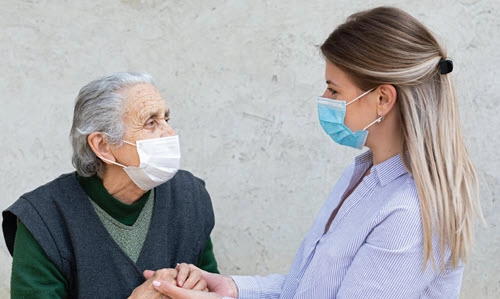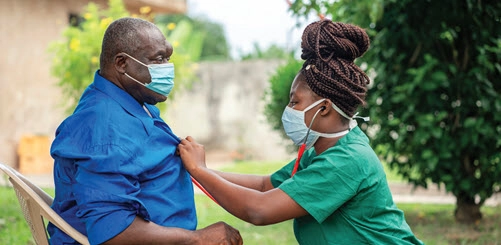Stay on Top of PHE Updates
Understand updated rules for PHE extension, in-person visits, infection control incentive payments, and more. Multiple government agencies have released updates that directly affect skilled nursing facilities, including issuing guidance that is different from what SNFs were previously told. With the COVID-19 pandemic, things are changing constantly, so make sure you have the most recent news, especially as the United States faces what appears to be a third spike in COVID-19 infections. Note These PHE Extension Specifics With no immediate end in sight for the pandemic, Department of Health and Human Services (HHS) Secretary Alex Azar extended the COVID-19 public health emergency (PHE) for another 90 days, effective Oct. 23 and running through Jan. 20, 2021. This is the third PHE extension HHS has made related to the coronavirus since its original declaration on Jan. 27, 2020. The agency first extended the PHE on April 21, and then again on July 23. Impact: “This means that the current rules and guidelines … that were relaxed during the PHE will remain in effect through most of January,” points out Acevedo Consulting in Delray Beach, Florida. This includes 1135 waivers and other flexibilities related to a myriad of Medicare policies from telehealth to lab tests to billing. Tip: As HHS keeps pushing back the PHE deadline, various federal agencies keep tweaking their COVID-19 policies and FAQs. The myriad agencies under HHS’ helm continue to alter guidance — sometimes daily — often reversing course and leaving providers with little or no time to get ready for major shifts. It’s crucial that organizations big and small revisit their policies weekly and put in the extra research online to avoid noncompliance with the latest Medicare billing changes — especially with some claims reviews back in action. Read the PHE renewal at www.phe.gov/emergency/news/healthactions/phe/Pages/covid19-2Oct2020.aspx. Follow These Rules for In-Person Visits The general prohibition of in-person visits (excepting end-of-life visits and contact with ombudspersons) was relaxed in September with the issuing of QSO memo 20-39-NH (see resource below), but, as infections again spike, make sure you follow the Centers for Medicare & Medicaid Services (CMS) and other agencies for current information on visitation rules. At the time of publication, official guidance includes the resumption of in-person visits, depending on local community transmission rates, and to hold all visits outside whenever feasible. This memorandum is meant to provide “reasonable” ways for facilities to manage in-person visitations safely, while also addressing the psychosocial needs of residents, says Linda Elizaitis, RN, RAC-CT, BS, president and founder of CMS Compliance Group in Melville, New York. “At many facilities, it has been difficult for residents to not feel socially isolated from their families and loved ones due to the visitation restrictions.” For indoor visitation, nursing homes should enable in-person access if their county has low (less than 5 percent) or moderate (5 to 10 percent) COVID-19 positivity rate — if facilities and visitors also follow core principles of infection control and prevention, like symptom screening, hand hygiene, source control, social distancing, visitor education regarding signs and symptoms, and use of personal protective equipment (PPE). “Failure to facilitate visitation, without adequate reason related to clinical necessity or resident safety, would constitute a potential violation of 42 CFR 483.10(f) (4), and the facility would be subject to citation and enforcement actions,” says David R. Wright, director of survey and certification group at CMS in Baltimore, in the memorandum. CMS has also expanded the definition of compassionate care, allowing or encouraging visitation for residents who are suffering — not just for those who are actively dying. This includes residents who seem less engaged, have suffered weight loss or dehydration due to lack of encouragement from a family member, are struggling with the adjustment of moving to a facility, or are grieving a loss. The memorandum also highlights ways facilities can use civil monetary penalty (CMP) funds to purchase equipment necessary to make in-person visits even safer, like clear partitions for indoor use or even outdoor tents. Resource: Read the memorandum in full here www.cms.gov/files/document/qso-20-39-nh.pdf. Know These Requirements for PRF Distributions You probably heard about the $2 billion in provider relief fund (PRF) payments HHS announced in early September, but did you catch that nursing homes and skilled nursing facilities must meet certain criteria to receive these incentive payments? Some of the criteria you may already meet: have active certification via Medicare or Medicaid, receive reimbursement from CMS and submit data for Certification and Survey Provider Enhanced Report (CASPER). Interested facilities must also meet certain standards surrounding COVID-19 infection rates, including keeping the facility infection rate lower than that of the county in which it’s located and keeping COVID deaths below a certain threshold. If your facility receives these payments, distribution of which started in September and will continue through December, it can use them for COVID-related expenses for residents and staff, including administering tests, reporting data, hiring additional employees, boosting infection control measures, and purchasing technology that can help reduce social isolation for residents. The payments are broken into $400 million chunks — per each month — with the last $400 million (at least) of incentive payments being made available to facilities that meet a certain performance threshold over the four-month period, say attorneys at Hall Render in Indianapolis in online analysis. HHS will use data from the National Healthcare Safety Network (“NHSN”) Longterm Care Facility Component COVID-19 Module, so make sure your facility is submitting timely and accurate information, especially if you wish to be considered for these payments. Check These Loopholes for Emergency Preparedness Plans In guidance for surveyors, CMS lightened some requirements for emergency preparedness plans (EPP) during PHE, which may apply to your facility. One major takeaway: If your facility has already activated its emergency plan, it’s probably exempt from certain regulations. “Facilities that activate their emergency plans are exempt from the next required full-scale community-based or individual, facility-based functional exercise. Facilities must be able to demonstrate, through written documentation, that they activated their program due to the emergency,” Wright says in memorandum QSO-20-41-ALL, emphasis original. If your facility was supposed to conduct an emergency preparedness exercise this year and did not due to the PHE, it may need to conduct an “exercise of choice,” Wright says, which could be a tabletop exercise assessing the facility’s response to COVID-19. The tabletop exercise may focus on aspects of COVID-related preparedness, including availability of PPE, isolation and quarantine areas for screening patients, or any other plans or protocols implemented with the activation of the EPP. Resource: Read the memorandum in full www.cms.gov/files/document/qso-20-41-all.pdf.


